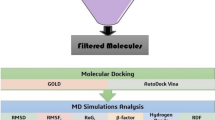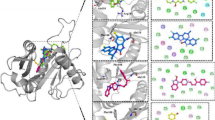Abstract
The emergence of carbapenem-resistant Acinetobacter baumannii, a highly concerning bacterial species designated as a Priority 1: Critical pathogen by the WHO, has become a formidable global threat. In this study, we utilised computational methods to explore the potent molecules capable of inhibiting the IspC enzyme, which plays a crucial role in the methylerythritol 4-phosphate (MEP) biosynthetic pathway. Employing high-throughput virtual screening of small molecules from the Enamine library, we focused on the highly conserved substrate binding site of the DXR target protein, resulting in the identification of 1000 potential compounds. Among these compounds, we selected the top two candidates (Z2615855584 and Z2206320703) based on Lipinski’s rule of Five and ADMET filters, along with FR900098, a known IspC inhibitor, and DXP, the substrate of IspC, for molecular dynamics (MD) simulations. The MD simulation trajectories revealed remarkable structural and thermodynamic stability, as well as strong binding affinity, for all the IspC-ligand complexes. Furthermore, binding free energy calculations based on MM/PBSA (Molecular Mechanics/Poisson–Boltzmann Surface Area) methodology demonstrated significant interactions between the selected ligand molecules and IspC. Taking into consideration all the aforementioned criteria, we suggest Z2206320703 as the potent lead candidate against IspC.








Similar content being viewed by others
Data availability
The data analyzed during the current study are available from the corresponding author on reasonable request as per the journal guidelines.
References
Adcock SA, McCammon JA (2006) Molecular dynamics: survey of methods for simulating the activity of proteins. Chem Rev 106(5):1589–1615
Amera GM, Khan RJ, Jha RK, Pathak A, Muthukumaran J, Singh AK (2020) Prioritization of Mur family drug targets against A. baumannii and identification of their homologous proteins through molecular phylogeny, primary sequence, and structural analysis. J Genet Eng Biotechnol 18(1):33
Ball HS, Girma MB, Zainab M, Soojhawon I, Couch RD, Noble SM (2021) Characterization and inhibition of 1-deoxy- d -xylulose 5-phosphate reductoisomerase: a promising drug target in Acinetobacter baumannii and Klebsiella pneumoniae. ACS Infect Dis 7(11):2987–2998
Berendsen HJC, Grigera JR, Straatsma TP (1987) The missing term in effective pair potentials. J Phys Chem 91(24):6269–6271
Bowie JU, Luthy R, Eisenberg D (1991) A method to identify protein sequences that fold into a known three-dimensional structure. Science 253(5016):164–170
Ceparano M, Baccolini V, Migliara G, Isonne C, Renzi E, Tufi D et al (2022) Acinetobacter baumannii isolates from COVID-19 patients in a hospital intensive care unit: molecular typing and risk factors. Microorganisms 10(4):1–13
Colovos C, Yeates TO (1993) Verification of protein structures: patterns of nonbonded atomic interactions. Protein Sci 2(9):1511–1519
Daina A, Michielin O, Zoete V (2017) SwissADME: a free web tool to evaluate pharmacokinetics, drug-likeness and medicinal chemistry friendliness of small molecules. Sci Rep 7(1):42717. https://doi.org/10.1038/srep42717
Dallakyan S, Olson A (2015) Small-molecule library screening by docking with PyRx. In: Hempel J, Williams C, Hong C (eds). Chemical Biology Methods in Molecular Biology. p. 1–11
De Lano WL (2004) Pymol: An open-source molecular graphics tool. CCP4 Newsletter on Protein Crystallography 40(1):82–92
Dhiman RK, Schaeffer ML, Bailey AM, Testa CA, Scherman H, Crick DC (2005) 1-Deoxy-D-xylulose 5-phosphate reductoisomerase (IspC) from Mycobacterium tuberculosis: towards understanding mycobacterial resistance to fosmidomycin. J Bacteriol 187(24):8395–8402
Gasteiger E, Hoogland C, Gattiker A, Duvaud S, Wilkins MR, Appel RD, et al (2005) Protein identification and analysis tools on the ExPASy Server; The Proteomics Protocols Handbook. Humana Press. 112:531–52
Haymond A, Johny C, Dowdy T, Schweibenz B, Villarroel K, Young R et al (2014) Kinetic characterization and allosteric inhibition of the Yersinia pestis 1-deoxy-D-xylulose 5-phosphate reductoisomerase (MEP synthase). PLoS ONE 9(8):e106243
Ibrahim S, Al-Saryi N, Al-Kadmy IMS, Aziz SN (2021) Multidrug-resistant Acinetobacter baumannii as an emerging concern in hospitals. Mol Biol Rep 48(10):6987–6998. https://doi.org/10.1007/s11033-021-06690-6
Jha RK, Khan RJ, Amera GM, Singh E, Pathak A, Jain M, et al (2020) Identification of promising molecules against MurD ligase from Acinetobacter baumannii: insights from comparative protein modelling, virtual screening, molecular dynamics simulations and MM/PBSA analysis. J Mol Model 26(11)
Jha RK, Khan RJ, Parthiban A, Singh E, Jain M, Amera GM et al (2021) Identifying the natural compound Catechin from tropical mangrove plants as a potential lead candidate against 3CLpro from SARS-CoV-2: an integrated in silico approach. J Biomol Struct Dyn. https://doi.org/10.1080/07391102.2021.1988710
Jha RK, Jabeer Khan R, Singh E, Kumar A, Jain M, Muthukumaran J et al (2022) An extensive computational study to identify potential inhibitors of Acyl-homoserine-lactone synthase from Acinetobacter baumannii (strain AYE). J Mol Graph Model 114(March):108168. https://doi.org/10.1016/j.jmgm.2022.108168
Kesharwani S, Sundriyal S (2021) Non-hydroxamate inhibitors of 1-deoxy-D-xylulose 5-phosphate reductoisomerase (DXR): a critical review and future perspective. Eur J Med Chem 213:113055. https://doi.org/10.1016/j.ejmech.2020.113055
Khan RJ, Singh E, Jha RK, Kumar A, Bhati SK, Zia MP et al (2023) Identification and prioritization of potential therapeutic molecules against LpxA from Acinetobacter baumannii—a computational study. Curr Res Struct Biol. 5:100096. https://doi.org/10.1016/j.crstbi.2023.100096
Krieger E, Joo K, Lee J, Lee J, Raman S, Thompson J et al (2009) Improving physical realism, stereochemistry, and side-chain accuracy in homology modeling: four approaches that performed well in CASP8. Proteins Struct FunctBioinforma 77(SUPPL. 9):114–122
Kumari R, Kumar R, Lynn A (2014) g_mmpbsa—a GROMACS Tool for high-throughput MM-PBSA calculations. J Chem Inf Model 54(7):1951–1962. https://doi.org/10.1021/ci500020m
Kumkar SN, Kamble EE, Chavan NS, Dhotre DP, Pardesi KR (2022) Diversity of resistant determinants, virulence factors, and mobile genetic elements in Acinetobacter baumannii from India: a comprehensive in silico genome analysis. Front Cell Infect Microbiol 12(November)
Kunfermann AC (2014) Structural and functional characterization of the non-mevalonate pathway enzymes IspC and IspD in complex with natural and synthetic ligands
Kunfermann A, Lienau C, Illarionov B, Held J, Gräwert T, Behrendt CT et al (2013) IspC as target for antiinfective drug discovery: synthesis, enantiomeric separation, and structural biology of fosmidomycinthiaisosters. J Med Chem 56(20):8151–8162
Laskowski RA, MacArthur MW, Moss DS, Thornton JM (1993) PROCHECK: a program to check the stereochemical quality of protein structures. J ApplCrystallogr 26(2):283–291
Laskowski RA, Rullmann JAC, MacArthur MW, Kaptein R, Thornton JM (1996) AQUA and PROCHECK-NMR: programs for checking the quality of protein structures solved by NMR. J Biomol NMR 8(4):477–486
Lienau C, Gräwert T, Alves Avelar LA, Illarionov B, Held J, Knaab TC et al (2019) Novel reverse thia-analogs of fosmidomycin: synthesis and antiplasmodial activity. Eur J Med Chem 181:111555
Lowe M, Singh-Moodley A, Ismail H, Thomas T, Chibabhai V, Nana T et al (2022) Molecular characterisation of Acinetobacter baumannii isolates from bloodstream infections in a tertiary-level hospital in South Africa. Front Microbiol 13(August):1–13
Luo L, Zhong A, Wang Q, Zheng T (2022) Structure-based pharmacophore modeling, virtual screening, molecular docking, ADMET, and molecular dynamics (MD) simulation of potential inhibitors of PD-L1 from the library of marine natural products. Mar Drugs 20(1)
Luthy R, Bowie JU, Elsenberg D (1992) Assessment of protein models with three-dimensional profiles. Nature 359(6364):83–85
Mac Sweeney A, Lange R, Fernandes RPM, Schulz H, Dale GE, Douangamath A et al (2005) The crystal structure of E. coli 1-deoxy-d-xylulose-5-phosphate reductoisomerase in a ternary complex with the antimalarial compound fosmidomycin and NADPH reveals a tight-binding closed enzyme conformation. J Mol Biol 345(1):115–127
Masini T, Hirsch AKH (2014) Development of inhibitors of the 2C-methyl-d-erythritol 4-phosphate (MEP) pathway enzymes as potential anti-infective agents. J Med Chem 57(23):9740–9763. https://doi.org/10.1021/jm5010978
Masini T, Kroezen BS, Hirsch AKH (2013) Druggability of the enzymes of the non-mevalonate-pathway. Drug Discov Today 18(23–24):1256–1262. https://doi.org/10.1016/j.drudis.2013.07.003
Mohan A, Rendine N, Mohammed MKS, Jeeva A, Ji HF, Talluri VR (2022) Structure-based virtual screening, in silico docking, ADME properties prediction and molecular dynamics studies for the identification of potential inhibitors against SARS-CoV-2 Mpro. Mol Divers 26(3):1645–1661. https://doi.org/10.1007/s11030-021-10298-0
Morris GM, Huey R, Lindstrom W, Sanner MF, Belew RK, Goodsell DS et al (2009) AutoDock4 and AutoDockTools4: automated docking with selective receptor flexibility. J Comput Chem 30(16):2785–2791. https://doi.org/10.1002/jcc.21256
Murkin AS, Manning KA, Kholodar SA (2014) Mechanism and inhibition of 1-deoxy-d-xylulose-5-phosphate reductoisomerase. Bioorg Chem 57:171–185. https://doi.org/10.1016/j.bioorg.2014.06.001
Naz S, Ngo T, Farooq U, Abagyan R (2017) Analysis of drug binding pockets and repurposing opportunities for twelve essential enzymes of ESKAPE pathogens. PeerJ 2017(9):1–16
Parveez Zia M, Singh E, Jain M, Muthukumaran J, Singh AK (2023) Structural and functional characterization of 1-deoxy-D-xylulose-5-phosphate synthase (DXS) from Acinetobacter baumannii: identification of promising lead molecules from virtual screening, molecular docking and molecular dynamics simulations. J Biomol Struct Dyn 8:1–14. https://doi.org/10.1080/07391102.2023.2174598
Pérez-Gil J, Rodríguez-Concepcíon M (2013) Metabolic plasticity for isoprenoid biosynthesis in bacteria. Biochem J 452(1):19–25
Rodriguez-Concepcion M, The MEP (2005) Pathway: a new target for the development of herbicides, antibiotics and antimalarial drugs. Curr Pharm Des 10(19):2391–2400
Šali A, Blundell TL (1993) Comparative protein modelling by satisfaction of spatial restraints. J Mol Biol 234:779–815
Sander T, Freyss J, von Korff M, Rufener C (2015) DataWarrior: an open-source program for chemistry aware data visualization and analysis. J Chem Inf Model 55(2):460–473. https://doi.org/10.1021/ci500588j
Schmid N, Eichenberger AP, Choutko A, Riniker S, Winger M, Mark AE et al (2011) Definition and testing of the GROMOS force-field versions 54A7 and 54B7. EurBiophys J 40(7):843–856
Schüttelkopf AW, Van Aalten DMF (2004) PRODRG: a tool for high-throughput crystallography of protein-ligand complexes. Acta Crystallogr Sect D BiolCrystallogr 60(8):1355–1363
Singh N, Cheve G, Avery M, McCurdy C (2007) Targeting the methyl erythritol phosphate (MEP) pathway for novel antimalarial, antibacterial and herbicidal drug discovery: inhibition of 1-Deoxy-D-Xylulose-5-phosphate reductoisomerase (DXR) enzyme. Curr Pharm Des 13(11):1161–1177
Singh E, Jha RK, Khan RJ, Kumar A, Jain M, Muthukumaran J et al (2022) A computational essential dynamics approach to investigate structural influences of ligand binding on Papain like protease from SARS-CoV-2. Comput Biol Chem 99(May):107721. https://doi.org/10.1016/j.compbiolchem.2022.107721
Testa CA, Johnson LJ (2012) A whole-cell phenotypic screening platform for identifying methylerythritol phosphate pathway-selective inhibitors as novel antibacterial agents. Antimicrob Agents Chemother 56(9):4906–4913
Trott O, Olson AJ (2010) AutoDock vina: improving the speed and accuracy of docking with a new scoring function, efficient optimization, and multithreading. J Comput Chem 31(2):455–461
Tsirigos KD, Peters C, Shu N, Käll L, Elofsson A (2015) The TOPCONS web server for consensus prediction of membrane protein topology and signal peptides. Nucleic Acids Res 43(W1):W401–W407
Umeda T, Tanaka N, Kusakabe Y, Nakanishi M, Kitade Y, Nakamura KT (2011) Molecular basis of fosmidomycin’s action on the human malaria parasite Plasmodium falciparum. Sci Rep 1:1–8
Van Der Spoel D, Van Maaren PJ, Berendsen HJC (1998) A systematic study of water models for molecular simulation: derivation of water models optimized for use with a reaction field. J Chem Phys 108(24):10220–10230
Van Der Spoel D, Lindahl E, Hess B, Groenhof G, Mark AE, Berendsen HJC (2005) GROMACS: fast, flexible, and free. J Comput Chem 26(16):1701–1718. https://doi.org/10.1002/jcc.20291
Wiederstein M, Sippl MJ (2007) ProSA-web: interactive web service for the recognition of errors in three-dimensional structures of proteins. Nucleic Acids Res 35(SUPPL2):407–410
Yu NY, Wagner JR, Laird MR, Melli G, Rey S, Lo R et al (2010) PSORTb 3.0: improved protein subcellular localization prediction with refined localization subcategories and predictive capabilities for all prokaryotes. Bioinformatics 26(13):1608–1615
Acknowledgements
The authors thank Sharda University.
Funding
Not applicable.
Author information
Authors and Affiliations
Contributions
MPZ and AKS conceived the concept of the study. MPZ wrote the manuscript and prepared the figures and tables. MJ, JM, and AKS corrected the manuscript. All authors approved the contents of the manuscript.
Corresponding author
Supplementary Information
Below is the link to the electronic supplementary material.
Rights and permissions
Springer Nature or its licensor (e.g. a society or other partner) holds exclusive rights to this article under a publishing agreement with the author(s) or other rightsholder(s); author self-archiving of the accepted manuscript version of this article is solely governed by the terms of such publishing agreement and applicable law.
About this article
Cite this article
Zia, M.P., Jain, M., Muthukumaran, J. et al. Exploration of potential hit compounds targeting 1-deoxy-d-xylulose 5-phosphate reductoisomerase (IspC) from Acinetobacter baumannii: an in silico investigation. 3 Biotech 14, 72 (2024). https://doi.org/10.1007/s13205-024-03923-w
Received:
Accepted:
Published:
DOI: https://doi.org/10.1007/s13205-024-03923-w




